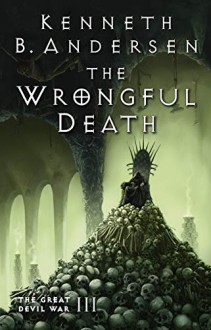
I received an ARC copy from the author but that has in no way influenced the review I freely chose to write.
I have read and reviewed the two previous books in Andersen’s series The Great Devil War (you can check my review here) and I loved them. I was more than happy when I heard the next book was ready and due for publication early in April. So, in case you are in a hurry, yes, I loved it as well. I have to add two caveats, though. The first one is a warning for readers who hate cliff-hangers. There is a big one at the end of the book. The book includes a teaser for book 4, and therefore we get a hint of what actually happens next, but the story itself is not completed in this volume. Yes, this is a series and is to be expected that the overall arch of the story will continue and is what happened with the two previous books, but they had a resolution to the main adventure in that particular tome, while that is not the case here. So if you hate cliff-hangers, stay away from this book, as it could make you quite angry. (I haven’t completely made up my mind about the subject. I don’t mind so much if I am sufficiently invested in the story and the characters, as I am in this series already, but if it’s totally unexpected and I don’t care for the characters, I am bound to not return to read the rest). The other caveat is a recommendation. There are enough reminders of Philip’s previous adventures in this novel to allow readers who’ve read the other books a while back to quickly find their bearings, but I don’t think it would work as an independent read, because there would be too much background missing to fully enjoy it. The series does not go into extremes of world-building or descriptions, but by now there is a lot of information and mythology that, although based on common themes and concepts (Heaven and Hell, stories in the Bible), help create an environment that is a big part of its charm. So, if you fancy the sound of it, start with number 1 and keep going.
I’ve already said I enjoyed it, as much as the other books at least. We get a bit of exposure to Philip’s everyday life, but that doesn’t last long, and we’re soon back in Hell and with Satina, Lucifer, Lucifax, and the rest of our favourite characters. But there are some new ones as well. We get to meet the artist behind the horrific paintings adorning Lucifer’s castle (paintings where the condemned can be seen suffering and heard screaming), we meet Chimera, a fascinating creature (yes, I want one); we finally get to go to Heaven and meet Jehovah (I won’t give you any hints, but his relationship with Lucifer is… well, entertaining), also visit the garden of Eden, Saint Peter (I loved the fact that when he falls asleep his halo falls off his head), and we visit other underworlds, Hades in this case, and that brings us plenty of Greek mythology to contend with (and great characters as well).
There are also the guest star appearances, in Hell and in this case also in Heaven, famous figures from the past that Philip meets in his travels. I will keep my peace, but I particularly liked their encounter with a famous writer whose creations had also come to live. (Yes, Stephen King, be scared!).
The story moves at good pace, there is plenty of intrigues, action, betrayals, the quest motif, more than a hint of romance (but nothing explicit), and the humorous touches as well. The writing style is fluid and easy (the story is told in the third person from Philip’s point of view, as usual), and the characters are solid and engaging. The novel turns darker towards the end, and although the whole series has never been all light and fun (among the subjects discussed are family losses, reflections on good and evil, religious themes, guilt and its consequences, moral ambivalence, death and mortality to name but a few), the whole book hints at horrific things to come, and even the good things that happen come hand in hand with bad consequences. The main character is growing up and so are his concerns, and that makes it a series definitely worth following and watching for.
Any negatives? Well, apart from the cliff-hanger already mentioned, I guess that people who’ve just read the previous two books might feel they don’t need any reminders of the previous stories. (I didn’t find that a problem). I also wondered how well this series would work for young readers of cultures not so familiar with the Bible. I guess it might work as just another fantasy world, but I suspect some of the in-jokes might be lost. Despite the fantastical setting, this is a pretty conventional story when it comes to the main character and his background, so it might not suit readers looking for a more inclusive and diverse kind of storytelling.
As I had said before, this is a book I’d recommend to readers of fantasy, both YA and adults, but it does have pretty dark moments, there is violence (some behind closed doors), and it will not suit people who prefer light reads or are particularly squeamish. Its take on religion can put some people off as well, but I guess the description of the series gives a clear indication of that. A great read and another gripping visit to the universe of the Devil War. I cannot wait for the next instalment.




 Log in with Facebook
Log in with Facebook 








